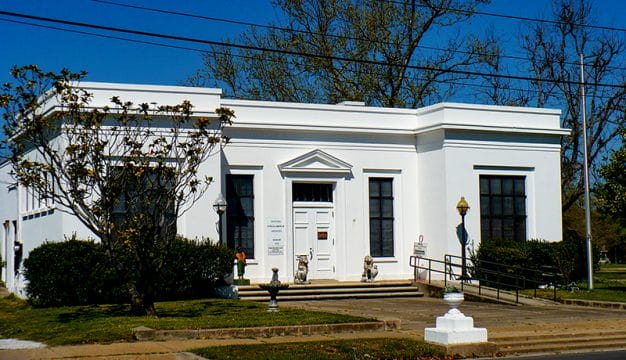Grand Hotel Golf Resort and Spa
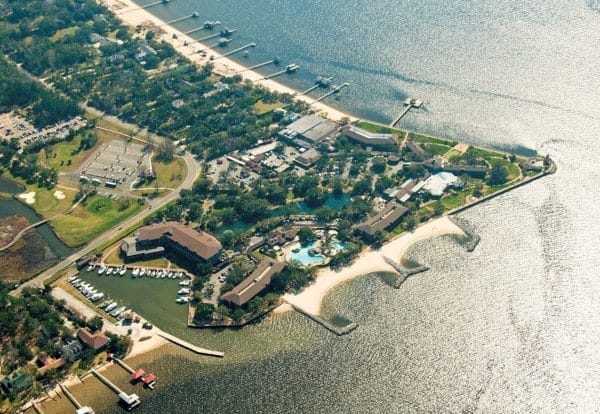 Grand Hotel Aerial View
The Grand Hotel Golf Resort and Spa, in Fairhope, Baldwin County, is the first of the Retirement Systems of Alabama‘s (RSA) eight hotels on the Robert Trent Jones Golf Trail. The current site of the resort has hosted a hotel since 1822 and sits on the Eastern Shore of Mobile Bay. The hotel has welcomed guests from American presidents to leaders and generations of families from around the world and has been recognized by the Historic Hotels of America since 2011.
Grand Hotel Aerial View
The Grand Hotel Golf Resort and Spa, in Fairhope, Baldwin County, is the first of the Retirement Systems of Alabama‘s (RSA) eight hotels on the Robert Trent Jones Golf Trail. The current site of the resort has hosted a hotel since 1822 and sits on the Eastern Shore of Mobile Bay. The hotel has welcomed guests from American presidents to leaders and generations of families from around the world and has been recognized by the Historic Hotels of America since 2011.
The Eastern Shore of Mobile Bay has attracted vacationers and year-round residents for the last 200 years. The original Grand Hotel was built in 1847 by F. H. Chamberlin as a two-story building with 40 rooms and two accessory buildings that housed the dining room and the bar. The entire complex stretched along some 100 feet of shoreline, and guests originally traveled to the hotel by steamboat. It was extremely successful, and Chamberlin soon purchased a nearby building, known as the Gunnison House, to provide additional guest rooms.
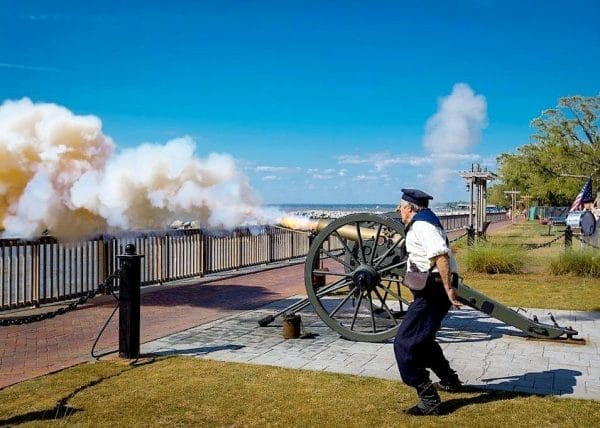 Grand Hotel Cannon
The business suffered a major setback with the outbreak of the Civil War in 1861. In 1863, a portion of the hotel became a Confederate hospital. Most of the soldiers sent to the hotel for recovery were from Missouri and were wounded during the Siege of Vicksburg, Mississippi, which took place from May 18-July 4, 1863. More than 300 Confederate soldiers died at the Grand Hotel and were buried in mass graves shoulder-to-shoulder in Confederate Rest, a cemetery on the resort property near what is now the Azalea golf course. Hotel staff continue to fire a cannon each evening as a tribute to the war dead. During the Battle of Mobile Bay in August 1864, Adm. David Farragut, the commanding Union naval officer, fired cannons from boats onto the hotel grounds. Indeed, a hole was discovered in the wall of the Gunnison House, which was located on the site of the Conference Center today.
Grand Hotel Cannon
The business suffered a major setback with the outbreak of the Civil War in 1861. In 1863, a portion of the hotel became a Confederate hospital. Most of the soldiers sent to the hotel for recovery were from Missouri and were wounded during the Siege of Vicksburg, Mississippi, which took place from May 18-July 4, 1863. More than 300 Confederate soldiers died at the Grand Hotel and were buried in mass graves shoulder-to-shoulder in Confederate Rest, a cemetery on the resort property near what is now the Azalea golf course. Hotel staff continue to fire a cannon each evening as a tribute to the war dead. During the Battle of Mobile Bay in August 1864, Adm. David Farragut, the commanding Union naval officer, fired cannons from boats onto the hotel grounds. Indeed, a hole was discovered in the wall of the Gunnison House, which was located on the site of the Conference Center today.
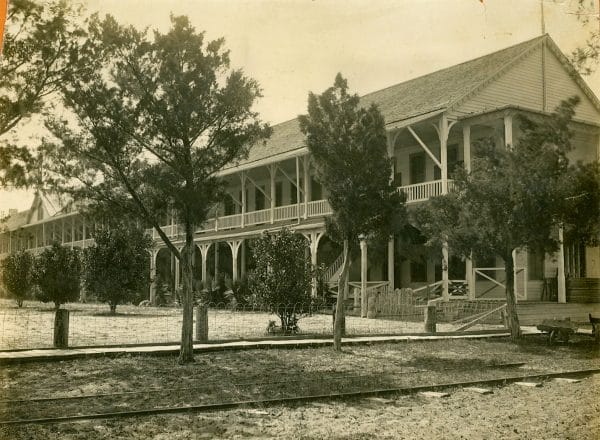 Grand Hotel, 1901
Chamberlin continued operating the hotel until 1871, when a steamboat explosion damaged the pier. He again offered the hotel as a hospital to treat victims of the disaster. He soon after sold the hotel to steamboat captain Henry C. Baldwin, who built a larger, expanded facility, which maintained the name Grand Hotel and reopened it in 1875. The new hotel was three times larger than the earlier structure, with two stories and 60 suites. When Baldwin died in 1878, his son-in-law George Johnson took over management of the resort. In 1893, a hurricane destroyed portions of the hotel, and Johnson rebuilt them. In 1901, Johnson sold the hotel and 250 acres east of the property to James K. Glennon, under whom the hotel endured severe hurricane damage in 1906 and 1916 as well as the economic decline of the Great Depression. In 1939, he sold the hotel and 25 adjacent parcels to Edward A. Roberts, chair of the Waterman Steamship Corporation. The old buildings were demolished and the new hotel, which also retained the Grand Hotel name, opened with air conditioning and 90 guest rooms in 1942. He added several private cottages for wealthy clientele soon after.
Grand Hotel, 1901
Chamberlin continued operating the hotel until 1871, when a steamboat explosion damaged the pier. He again offered the hotel as a hospital to treat victims of the disaster. He soon after sold the hotel to steamboat captain Henry C. Baldwin, who built a larger, expanded facility, which maintained the name Grand Hotel and reopened it in 1875. The new hotel was three times larger than the earlier structure, with two stories and 60 suites. When Baldwin died in 1878, his son-in-law George Johnson took over management of the resort. In 1893, a hurricane destroyed portions of the hotel, and Johnson rebuilt them. In 1901, Johnson sold the hotel and 250 acres east of the property to James K. Glennon, under whom the hotel endured severe hurricane damage in 1906 and 1916 as well as the economic decline of the Great Depression. In 1939, he sold the hotel and 25 adjacent parcels to Edward A. Roberts, chair of the Waterman Steamship Corporation. The old buildings were demolished and the new hotel, which also retained the Grand Hotel name, opened with air conditioning and 90 guest rooms in 1942. He added several private cottages for wealthy clientele soon after.
During World War II, the U.S. Army requested that Roberts lease the Grand Hotel to the U.S. Army Air Corps to be used as its Marine Training Command center to prepare servicemen, who would repair aircraft, for life at sea. The cottages and rooms were converted to barracks. After the war, Roberts continued improving and expanding the site, adding a marina, two tennis courts, an 18-hole golf course, the Lakewood Club, and a swimming pool. In 1955, he sold the site to a large corporation, which in turn sold it to North Carolina businessman Malcolm McLean, who sold it to his brother James McLean. McLean expanded the hotel again and added ten luxury cottages and a conference center. He also added a nine-hole course to the golf complex.
In 1979, the hotel closed after it was damaged by Hurricane Frederic and reopened in 1980. In 1981, Marriott International purchased the resort and added the North Bay House and the Marina Building, bringing the total number of guest rooms to 306. In 1986, the old Gunnison House was torn down to make way for the Grand Conference Center, and nine additional golf holes were added for a total of 36 holes.
In 1999, RSA financed the purchase of the Grand Hotel and the Lakewood Club. At the time, there were 306 guest rooms in four buildings on 550 acres, 22,000 square feet of meeting space, three restaurants, 10 tennis courts, bike trails, a 37-slip marina, and 36 holes of golf with a clubhouse and driving range. RSA completely renovated the main lobby, restaurants, meeting rooms, and existing guest rooms and added the four-story Spa Building with 126 rooms, 20,000-square-foot spa, new aquatics center, beach, fitness center, and an indoor pool.
 Lakewood Club Golf Complex
The hotel was damaged by Hurricane Ivan in 2004 and again by Hurricane Katrina in 2005. Extensive repairs were made, and the ballroom and meeting areas were completely redone and the guest rooms, dining area, and kitchen were totally renovated. The two 18-hole golf courses also were redesigned in 2004 and 2005 and included the addition of six artificial lakes and a state-of-the-art practice facility, updated drainage and leveling, and a renovated driving range. The complex includes a two-acre short game area and a 1,500-square-foot range house with refreshment bar. The Marriott franchise agreement was executed for all of RSA’s hotels in 2005 and the hotel was renamed the Grand Hotel Marriott Resort and Spa. In 2008, RSA refurbished the golf clubhouse, constructed a restaurant and aquatics/tennis/fitness complex, and added Sweetwater Lake to the Lakewood Club.
Lakewood Club Golf Complex
The hotel was damaged by Hurricane Ivan in 2004 and again by Hurricane Katrina in 2005. Extensive repairs were made, and the ballroom and meeting areas were completely redone and the guest rooms, dining area, and kitchen were totally renovated. The two 18-hole golf courses also were redesigned in 2004 and 2005 and included the addition of six artificial lakes and a state-of-the-art practice facility, updated drainage and leveling, and a renovated driving range. The complex includes a two-acre short game area and a 1,500-square-foot range house with refreshment bar. The Marriott franchise agreement was executed for all of RSA’s hotels in 2005 and the hotel was renamed the Grand Hotel Marriott Resort and Spa. In 2008, RSA refurbished the golf clubhouse, constructed a restaurant and aquatics/tennis/fitness complex, and added Sweetwater Lake to the Lakewood Club.
In 2018, buildings and other indoor and outdoor facilities at the hotel were transformed through more renovations to qualify as part of Marriott’s high-end Autograph Collection. The South Bay Building, North Bay Building, and Marina Buildings were gutted down to the concrete walls and redone. The Spa Building and Main Building were totally redecorated. The pool area added rental cabanas and a splash pad, and the recreation and games area with putting greens and other lawn games were moved to the pool area. Three new signature restaurants and an outdoor dining patio were added, and all existing dining venues were transformed. The two courses were renovated again in 2018 and 2019 as well.
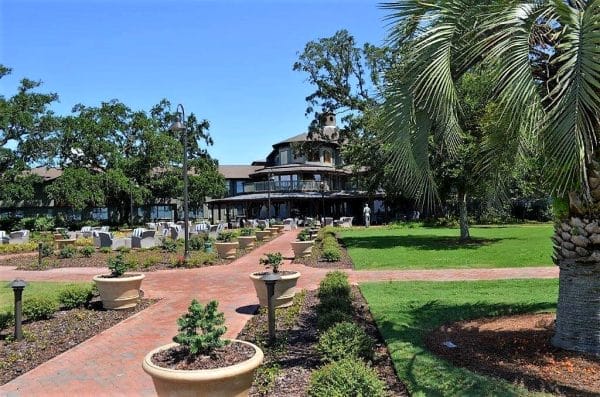 Grand Hotel Dining Patio
The Grand Hotel Golf Resort & Spa, Autograph Collection was ranked “Number 1 in Alabama” by U.S. News and World Report. Other notable awards include Top 20 Resorts in the South, 31st Best Resort in America and Canada, and Top 125 Resorts in the World ratings by Condé Nast Traveler; Top 500 Hotels in the World and Top 50 Best Resorts in America and Canada by Travel and Leisure; and Golf magazine’s Best Golf Resorts in America. It has also received the Best Historic Hotel of the Year Award from Historic Hotels of America, was named among the Top 5 Resorts in the Nation by Southern Living, and ranked third Best Historic Hotel in a public vote in USA Today.
Grand Hotel Dining Patio
The Grand Hotel Golf Resort & Spa, Autograph Collection was ranked “Number 1 in Alabama” by U.S. News and World Report. Other notable awards include Top 20 Resorts in the South, 31st Best Resort in America and Canada, and Top 125 Resorts in the World ratings by Condé Nast Traveler; Top 500 Hotels in the World and Top 50 Best Resorts in America and Canada by Travel and Leisure; and Golf magazine’s Best Golf Resorts in America. It has also received the Best Historic Hotel of the Year Award from Historic Hotels of America, was named among the Top 5 Resorts in the Nation by Southern Living, and ranked third Best Historic Hotel in a public vote in USA Today.
Further Reading
- Fagan, Mark. The Robert Trent Jones Golf Trail: Its History and Economic Impact. Montgomery, Ala.: NewSouth Books, 2016.
- ———. Coastal Alabama Economic History. Pennsauken, N.J.: BookBaby, 2018.
- ———. Alabama’s Public Pension Fund Growth and Economic Expansion since 1973. Pennsauken, N.J.: BookBaby, 2019.
- ———. Retirement at The Colony at The Grand. Montgomery, Ala.: The Retirement Systems of Alabama, 2019.

